Reprinted from Saltscapes May 2006 (Copyright ©2006 David Tilley)

Rock
OF AGES
In a world where change is the only constant,
The rock offers an unshakeable geological foundation
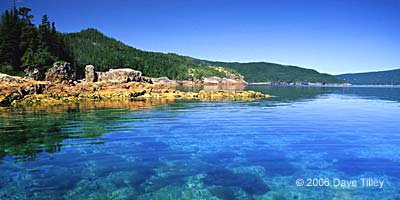
Crystal clear waters reveal hues of emerald turning to gold along the salt encrusted shoreline of Birchy Cove in Green Bay.
Photography and text by Dave Tilley
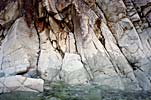
If the early explorer John Cabot first encountered North America at the jagged cliffs of Cape Bonavista, NL, he must have arrived with mixed emotions. The rock walls towering above Spillars Cove give way to a menacing array of sea stacks spalling off from the mainland in various stages of formation - a line of defence capable of smashing any vessel that ventures near in heavy seas. It was here
that the daring rescue of surviving crew members from the ill-fated shrimp dragger Ryan′s Commander took place during a raging storm in the fall of 2004. For generations islanders have struggled with the elements on sea and land, shaped by adversity into a people of distinctive character and fortitude. The headlands themselves are engaged in an eternal duel with a relentless sculptor; they are a masterwork of stark beauty. Famous for understatement, islanders have nicknamed their home The Rock. The soil was scraped from the land by
glaciers and dumped into the ocean, spawning what was to become the world′s richest fishing grounds. For centuries the island was a fishing station for foreign vessels. When permanent settlement took hold it was fragmented along the isolated coves and harbours of an irregular and extensive coastline. To avail themselves of adjacent fishing grounds, settlers built houses on cliff edges and on moorings over the water. A harsh climate and few onshore resources meant an overwhelming dependence on fish and marine life.
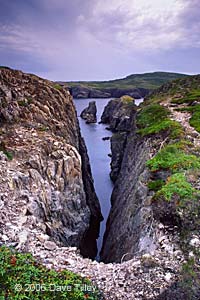
A coastline in transition. Waves hammering at the loose rock gradually chisel out weather resistant sea stacks ( known locally as spillars ) that can be found in various stages of formation along the shores of Cape Bonavista. Isolation from land based predators make them ideal nesting sites for our Provincial bird the Atlantic Puffin. |
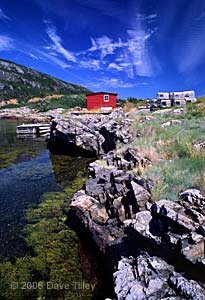
Rocky shorelines are home to fishing stages and wharves in the picturesque community of Salvage. |
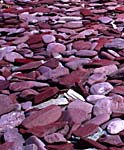
A long and colourful human history is underlain by deep geologic roots. Borrowing on pieces of seafloor, mantle and two separate continents, Newfoundland and Labrador offers a window into the distant past, retracing the complex metamorphosis of the planet. Geologic wonders, like time capsules washed up on a present day shore, can offer a trip back to a time when the primal forces of
nature ruled over all creation. The Earth would have been unrecognizable to us half a billion years ago. Locked together in jigsaw fashion, slabs of the Earth′s outer crust drift-then, as now-like stone rafts in a sea of magma. As they race at speeds of up to 10 centimetres per year parts rearrange themselves, giving the world a facelift every few hundred million years. The strange and unexpected appearance of the fossil-bearing cliffs of Table Point-pushed up from a deep, ancient seafloor-transport the visitor to a strange world. Forgotten by time, the wave-sculpted limestone beds have the appearance of ancient ruins at the edge of a primordial sea. The Tablelands of Gros Morne could be an artist′s concept of the Martian landscape. Pitched up from the bowels of the earth, a huge exposed section of the mantle lies virtually unaltered. The rusted iron-baring rock is inhospitable to all but the most tenacious forms of plant life and the most heavily constructed hiking boots. Free of most vegetation, it offers a veritable laundry list of textbook glacial features. Students on field trips from colleges in nearby Corner Brook are frequent patrons. One of the best-preserved and uncrowded parks in North America, Gros Morne offers a field day for any hiker looking to get away and see something different. Throughout the park narrow fjords scoured by glaciers-then dammed at the mouth by rising coastal plains-wind deep into the Long Range Mountains, their steep walls blocking the sun. At Western Brook Pond 600-million-year-old cracks climb skyward, telling of the parting of an ancient continent.
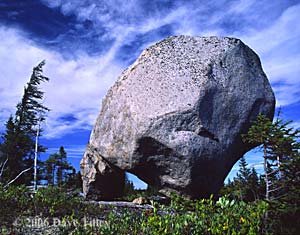
Balancing act. Ice fields, powerful enough to displace and transport large chunks of bedrock gently melted away to leave weathered boulders perched in unlikely positions.
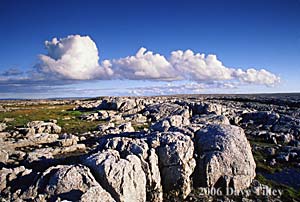
Calcareous ( limestone ) conglomerate boulders and bedrock stretch inland from Cape Norman. The sub arctic climate, wind and frost exposure at the Northern tip of the island create a ecological niche for rare species of plants.
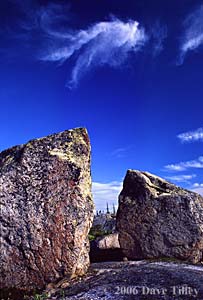
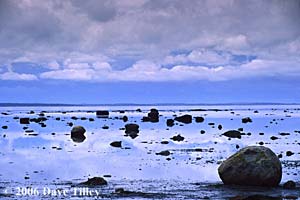
The outgoing tides reveal the rocky nature of Pistolet Bay.
Opening into the strait
of Belle Isle, it is enveloped by a open landscape of rock barrens and marshes.
Large granite boulders scattered through the open
country tell of an earlier time when glaciers dominated.
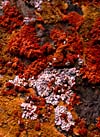
Inland, rock dominates the landscape of the upland barrens. Paved walkways wander through stone mansions, glacial erratics that appear abruptly on the horizon as if dropped from the heavens. Bands of nomadic
caribou are true to trails that offer year-round access to plants and lichens left bare when winter howls through the high country. The barrens are a gaming range like no other, a happy hunting ground where ease of movement and visibility level the playing field for hunters outwitted by keen animal senses.
Land, sea and sky meld into one where the Great Northern Peninsula juts into the ocean, a landscape of the most basic elements. The rocks are an anchor that offer scale and direction. Limestone barrens, encompassing the wide expanse of Pistolet Bay, greet the horizon. Between the roughened, rounded boulders hide rare plant species-Fernalds braya, alpine arnica, dwarf hawks beard-specialists who have carved a niche where no others could.
Here the sea′s bounty becomes apparent each spring, as huge pods of spouting humpbacks meet a parade of titanic icebergs carried on the Labrador Current, through the straits and down the coast. At one time both were frowned upon as perils to navigation and fishing, but they now offer a hook for entrepreneurs. In addition to a boon in tourism, the growing worldwide demand for bottled water has led to a budding iceberg harvesting and export industry, an example of how a resourceful people continue to wring a livlihood from the sea.
